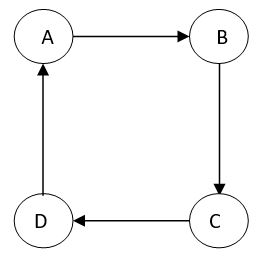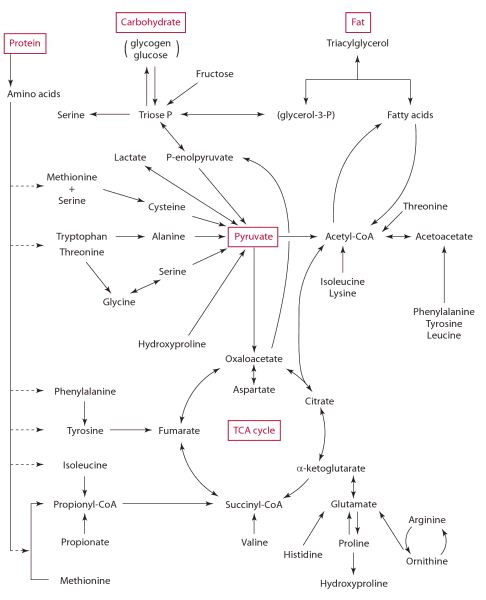Introduction
The biochemical reactions that occur with living cells are all referred to as metabolic reactions. In all organisms, metabolic reactions can either take the form of anabolism or catabolism. Catabolism describes all metabolic reactions in which large molecules are broken down to smaller and in the process, a release of energy occurs (Bhagavan 34). Anabolism on the other hand describes metabolic reactions in which small molecules are joined together to form larger molecules. Anabolic reactions generally require energy to take place. An example of an anabolic reaction is the creation of proteins from amino acids.
In all organisms, metabolic reactions occur in series referred to as metabolic pathways. A metabolic pathway is a series of progressive biochemical reactions utilized by a cell to transform an input substance into an end product (Gropper and Smith 64). The pathways can be cyclic, in which the biochemical reactions reproduce the initial product, or linear, in which reactions produce a different product.


All life forms share the same metabolic pathways. In human beings, the main metabolic pathways include carbohydrate (glycolysis, gluconeogenesis, and glycogen) metabolism, lipid (fatty acid) metabolism, and protein (amino acid) metabolism (Garrett and Grisham 551). If consumed in adequate quantities, any of the three energy-creating nutrients i.e. carbohydrates, proteins, and fat, can avail energy to the body on a short-term basis. The biochemical pathways always occur in one direction and interact in a complex manner to enable ample regulation.
Interaction of Biochemical Pathways
A central array of metabolic pathways exists within all living things. These pathways are responsible for the breakdown of essential nutrients into Adenosine Triphosphate (ATP) and other molecules necessary for the release of energy into the body. As shown in figure 3, all metabolic pathways interact in one form or another during the energy production process. The interrelationships of metabolic pathways take various forms and always result in three junction points: glucose-6-phosphate, Pyruvate, and Acetyl CoA (Stoker 503). The fact that human beings can gain fat on a predominantly carbohydrate diet is evidence that the metabolic pathways interact and that nutrients can be converted from one form to another.

Connections of other sugars to glucose metabolism
In all animals, energy is stored in the glycogen molecule. In situations where the body has ample ATP present, excess glucose is converted into glycogen for storage (Rosenthal and Glew 57). Glycogen is prepared and stored in both the human muscles and the liver. When the blood sugar drops, glycogen monomers are broken down to form glucose. The carbohydrate (glycolytic) pathway occurs when the synthesis of glycogen monomers forms glucose-6-phosphate (G-6-P) which can later provide energy for the human body.
Sucrose, a disaccharide that consists of a fructose molecule plus a glucose molecule is broken down to form both fructose and glucose. Fructose plus galactose and glucose form the three main monosaccharide diets. Galactose is a milk product that is generally absorbed into the bloodstream directly after digestion. Glucose metabolism produces energy by converting glucose into pyruvate. Glycolysis consists of 10 biochemical reactions in which various intermediates act as the entry points for further reactions. The hexokinases enzymes carry out the phosphorylation of glucose to form glucose-6-phosphate. While the reaction utilizes ATP, it also maintains a low glucose concentration thus ensuring that glucose flows into the cell while at the same time blocking glucose from flowing out of the cell (Lee and Bishop 36). While glucose can be absorbed directly after digestion, living tissues can convert other sugars into glucose in the fast phase to provide energy or convert them in the fed state into fat to be stored for future use.
Connections of lipid and glucose metabolism
In metabolic connections, lipids link with glucose pathways through triglycerides and cholesterol. For animals, fat is very important for the storage and subsequent release of energy. All tissues utilize fatty acids as energy storage mechanisms as well as the means of creating cell membranes. The normal human body ingests lipids as triglycerides that are impossible to absorb by the intestines (Gropper and Smith 63). The pancreatic lipase enzyme breaks down these lipid molecules into glycerol and free fatty acids. Triglycerides can be both broken down or created through phases of the glucose metabolism pathways. Glycolysis occurs by the way of the phosphorylation of glycerol into glycerol-3-phosphate. Glycogen from muscles and the liver can feed into the catabolic pathways for carbohydrates (Stoker 545).
The catabolism of lipids occurs through beta-oxidation that occurs in the matrix of mitochondria and changes fatty acids into acetyl groups. Tissues then incorporate these groups into CoA to create Acetyl CoA that continues further into the Krebs cycle.
In certain situations, the body oxidizes carbohydrates to create both the fatty acid and glycerol portions of triacylglycerol (TAG). The transformation of fatty acids into carbohydrates is however impossible as the dehydrogenase reaction of pyruvate goes in one direction and is irreversible.
Connections of Proteins to Glucose Metabolism
The hydrolysis of proteins in human cells occurs through a variety of enzymes. Generally, tissues synthesize amino acids into new proteins when needed. However, if the body is starving, or in a situation where there are excess amino acids, part of these amino acids will be pushed into the glucose catabolic pathways (Gropper and Smith 251). Before an amino acid enters the glucose metabolic pathway, its amino group is detached and transformed into ammonia. Amino acids are metabolized into both the ketogenic amino groups and the glucogenic amino groups (Grisham and Garrett 101). Through oxidation, both the ketogenic and non-essential amino acids can indirectly from fatty acids. Carbohydrates can also result from the oxidation of the non-essential glucogenic amino acids.
Fed-Fast Cycle
The fed-fast cycle provides a very concise description of the interrelationship of the different metabolic pathways. During the fed state, glucose is readily available in various tissues and is usually absorbed directly to provide the required energy. In this state, enzymes in the liver convert excess glucose into fatty acids and glycogen (Gropper and Smith 252). The transformation of glucose into fatty acids only takes place when energy use is far lower than the intake.
During the post-absorptive phase, the tissues are unable to obtain energy from consumed glucose and the other nutrients but must rely on other energy sources. During this phase, glycogenolysis occurs in the liver where the synthesis of triacylglycerol and glycogen occurs to maintain the glucose levels in the blood (Grisham and Garrett 761). In the muscles, lactate is stored and released as required and becomes an essential energy source. The amino group alanine from the liver enters the glucose-alanine cycle and glycogenolysis occurs to transform this amino group into pyruvate.
In the fasting state, the hydrolysis of proteins in the muscles to create glucogenic amino acids increases. In this state, amino acids from protein breakdown form the bulk of the substrates needed for gluconeogenesis (Stoker 613). Through lipolysis, glycerol is also a chief provider of energy in this phase. Apart from this, anaerobic metabolism occurs in the muscles to create lactate that also offers a means for energy provision. In this phase, all the macronutrients offer a means of energy through various reactions in the body.
In the starvation phase, the body struggles to conserve essential proteins required for antibodies, hemoglobin, and enzymes. In this phase, fat stores in the body act as the major source of energy. Metabolic reactions shift from gluconeogenesis to lipolysis (Gropper and Smith 258). However, the brain cannot utilize fatty acids as a source of energy as they cannot move across the blood-brain barrier. The brain thus utilizes ketone as its main source of energy during the starvation phase. At this phase, an organism can only continue to exist depending on the amount of fat stored earlier.
Conclusion
Metabolism is a porous reaction in the body in which all metabolic pathways interact to provide the necessary energy required. Carbohydrates, lipids, and amino acids all interact at the three junction points to provide the required molecules needed for energy production. The intersection points are Acetyl CoA, glucose-6-phosphate, and Pyruvate. Carbohydrates, lipids, and amino acids can all provide energy through different processes in the body. The glucose pathway relates to all the other pathways and is a major provider of energy in the body during the fed-fast phase. All living things require energy and share the same metabolic reaction. The three main metabolic reactions interrelate to provide essential energy-providing molecules for any living thing.
References
Bhagavan, Natali. Medical Biochemistry. Malaysia: Academic Press, 2012. Print.
Grisham, Charles and Reginald Garrett. Biochemistry. 5th ed. Belmont, CA: Brooks/Cole Cengage Learning, 2013. Print.
Gropper, Sareen and Jack Smith. Advanced Nutrition and Human Metabolism. 6th ed. Belmont, CA: Wadsworth-Cengage Learning, 2012. Print.
Lee, Gary and Penny Bishop. Microbiology and Infection Control for Health Proffessionals. French Forest: Pearson Australia, 2012. Print.
Rosenthal, Miriam and Robert Glew. Medical Biochemistry: Human Metabolism in Health and Diseases. New Jersey, NJ: John Wiley and Sons, 2009. Print.
Stoker, Stephen. Organic and Biological Chemistry. 7th ed. Boston, MA: Cengage Learning, 2015. Print.